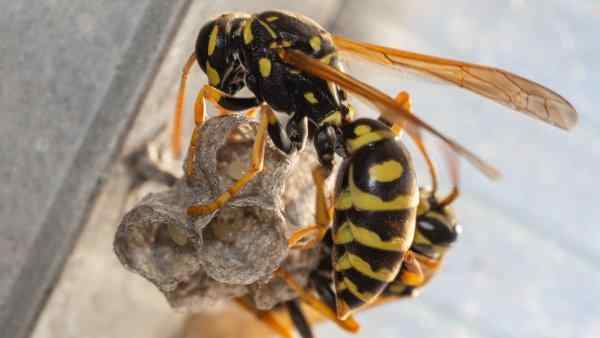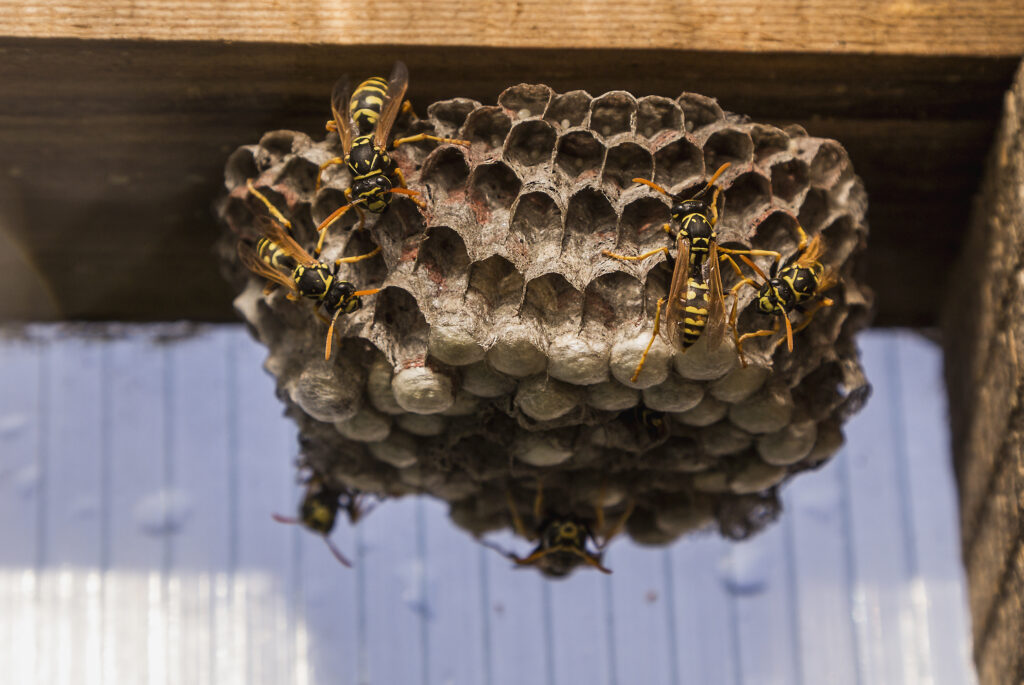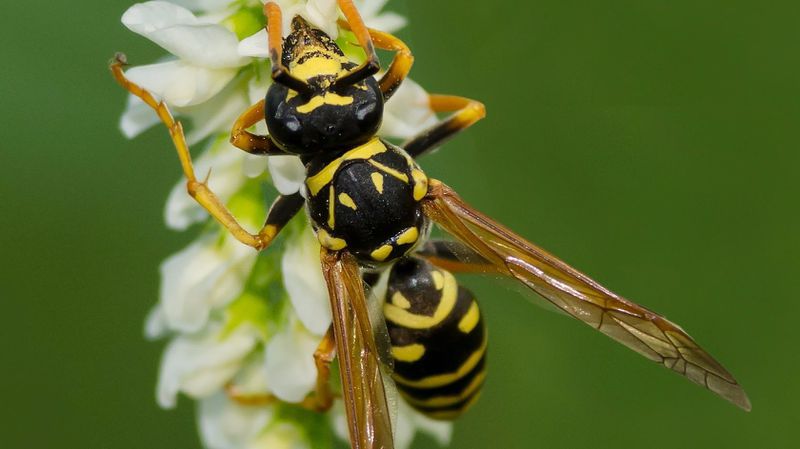Gardening: How to get rid of wasps nesting in the lawn
Q: Not sure you are able to help us, but for the last three to four years we have had ground hornets nesting in the lawn. This year seems exceptionally bad. They come late July and dig, and are usually gone in September. Is there any reason they are infesting our lawn? Is there anything we can do? We did try a spray down the tunnel, but they just seem to move to another area. I do not see them in the neighbors’ yards.
A: The first step is to determine what insect you are dealing with. There are two common ground-dwelling predatory wasps around here. The first is the ground digger wasp or cicada killer wasp (Schecies speciosus). They are large (about 2-inches long) black and yellow insects. These insects are generally safe to leave alone unless the nest is in a high-traffic area.
The bees nest in bare soil, so plant something — grass, ground cover, for example to eliminate potential nesting sites. These insects are solitary. The females spend their time digging small burrows and stocking them with paralyzed cicadas, which is food for their larvae.
Look for their nests in a sunny spot with loose, well-drained soil, usually near trees, potential hunting grounds for cicadas. While the females do sting, they are very tolerant and will not attack unless they feel threatened. The males are stingless but territorial. Expect them to fly around you, even bumping into you when you encroach on their territory.
The second possibility is a very aggressive type of wasp. These are less than an inch long and are commonly called yellow jackets (Vespula sp.). While these are also considered beneficial as they eat other insects, they are attracted to other sources of meat like your grilling steaks or your pet’s food dish. Yellow jackets also are dangerous because each insect can sting multiple times, and there can be hundreds of wasps in the nest.
Only the mated queens survive the winter. They look for holes in the soil, leaf litter, compost piles, cavities in dead logs or stumps, under loose bark or even in the siding of your home. The queens stay protected from November until warm weather in the following April. The queens emerge and look for a good nesting site.

How to get rid of wasps
Learn how to get rid of wasp and hornet nests safely, and stop insects from building them in the first place.
Wasps are frightening creatures and they can put a damper on outdoor activities. However, not all of these creatures sting and some of them are beneficial to our ecosystem. Without them acting as our natural pest control, our world would be swamped by insects.
What are the differences between wasps and bees?
Though both bees and wasps share similar physical characteristics, they are actually quite different in shape and size. Wasps have a narrow waist that connects their thorax to their abdomen, whereas bees are rounder and their bodies are made up of only one section.
Another way to distinguish them is to see if there’s any hair on them. Bees are hairy and wasps are hairless in comparison. You can also determine the creature by observing the types of diet they consume. Wasps feed on insects while bees feed only on pollen.
What do wasps look like?
Wasps can grow up to three to four cm long, but their size varies from species to species. However, they do share similar characteristics like having a pair of wings, a pair of antennae and six legs. Only the female species have stingers and their stings contain venom.
How to Get Rid of a Wasp’s Nest
Having a wasp’s nest in or around your home is an unpleasant situation to be in, especially if you have small children or somebody with an allergy to wasp stings. Your best bet is to call an exterminator, but if this isn’t an option and you’re not allergic to stings, you can likely take care of the problem yourself. To get rid of wasp’s nest, wear protective clothing, approach the nest at night when the wasps are less active, and thoroughly douse the nest in an approved pesticide spray, insecticidal dust, smoke, or water. Afterwards, you should take measures to also prevent wasps from returning in the future.
Ensure that you are not allergic to wasp stings. If you’re not sure whether you have an allergy to wasp stings or not, it’s a good idea to set up an allergy test with your doctor before you attempt to tackle the nest.
Contact your local vector control district. Though not available everywhere, vector control deals with disease-carrying or potentially dangerous insects and animals (vectors). These professionals can help you with identification, advise you on what to do, and may even remove the wasps for you
Call an exterminator. In most situations, it’s best to leave nest removal to the professionals. If there is no vector control district or they are unable to come remove the nest, try an exterminator instead. This is especially true if you have ground-nesting yellow jackets
Consider leaving the nest alone. If the wasps’ nest is far enough away from your house that it doesn’t pose a significant threat, you should consider leaving it alone, especially if it belongs to a less aggressive wasp species such as the paper wasp. Wasps are an important part of the ecosystem, as they pollinate plants and flowers and eat other garden pests such as caterpillars.

How to Get Rid of Wasps Around the House Naturally
There’s nothing worse than trying to enjoy the sunshine on a nice summer’s day only to hear threatening buzzing noises in your ear. While there are some buzzing insects that are more obnoxious than dangerous, wasps and yellow jackets are forces to be reckoned with. But how can you get rid of flying insects without introducing harmful products into your space?
Pest Control specializes in environmentally friendly pest control, including eliminating the threat of wasps, hornets, yellow jackets, and bees.
How Do You Keep Wasps Away from Your House?
The easiest way to deter wasps from hanging around in your yard is to keep them from nesting around your home. You can take the following steps to help reduce the likelihood of wasps nesting near your home:
Keep doors and windows shut
Take trash out regularly
Pot or plant wasp-repelling plants around the deck or yard
Seal garbage cans
Cover compost piles
Cover holes in the ground
What Smell Do Wasps Dislike?
Wasps have a large sense of smell and typically dislike more fragrant plants, including many herbs. There are several smells that wasps can’t stand, which can give you a leg up in your fight against the buzzing insects. Looking for some fragrant plants that pull double duty in smelling great and helping to deter wasps and hornets?
How Do You Get Rid of a Wasp Nest Without Harmful Substances?
While the best method to keep wasps away is to prevent them from building a nest in the first place, it’s possible to get rid of a wasp nest without using harsh products. But just getting rid of the wasp nest isn’t enough to resolve the issue; surviving wasps will return to reconstruct it. To ensure all the wasps are eliminated and therefore unable to come back, it’s best to treat the wasp nest at night while all the insects, including the queen, are present and far less aggressive than during the day.

How To Get Rid Of Paper Wasps
you may have reason for concern. Those are paper wasps and while they are fairly docile when they are away from their nests, they can become extremely aggressive when they are protecting a nest. If paper wasps have established a nest on your property, it can present a threat. That is why it is best to get rid of paper wasps right away. There is only one way to do this. That’s what we’re going to talk about today.
Nest Detection
The first step is to notice wasps nests as they begin to form. This has two components. You need to know what developing nests look like and you need to know where to look for them.
What Paper Wasp Nests Look Like — You may already know what a paper wasp nest looks like. These are common insects in the Dallas area. But you might not recognize a nest as it is forming. At first, it is only a small gray, umbrella shape, with hexagonal compartments inside. Once it is fully formed, it will be the shape of a strawberry.
Where You Can Find Wasp Nests — You may know this one as well. Paper wasps create their aerial nests in sheltered locations on, and around, man-made structures. Perhaps you’ve seen one under a roofline, on the ceiling of a porch, or under a deck, porch, or patio. These are only some of the many locations they build nests. The key to finding them is to look up. When you get under your deck to search for a nest, you need to look up. These insects get into the “rafters” of low lying structures as readily as they do the rafters of a barn.
Nest Removal
Once you’ve found a nest, it needs to be removed. If it is just a little starter nest, and there are no wasps present on the surface, you may be able to just brush it away with a broom. Do a quick inspection of the area and make sure there are no wasps nearby. If the nest has developed to a point where you are unable to see all the hexagonal chambers, there could be wasps inside that you can’t see. Removing these nests can be hazardous.
A few things to consider about DIY wasp nest removal:
Selecting the wrong product to spray a wasps’ nest can be hazardous.
Inappropriate application of wasp sprays can be toxic.
Climbing a ladder to spray a wasps nest can result in a fall.
Getting into a closed space with a wasps’ nests is a bad idea.
When you have a licensed and insured pest professional take care of wasp nests, you don’t have to worry about injury. You also don’t have to worry about the wrong methods or products being used to address the threat.
Professional Wasp Control and Nest Removal
Life gets busy. Who has time to be looking for developing wasps nests? There’s work, school, sporting events, recitals, family reunions, birthday parties—the list goes on and on. But you don’t have to think about nest detection when you have residential pest control